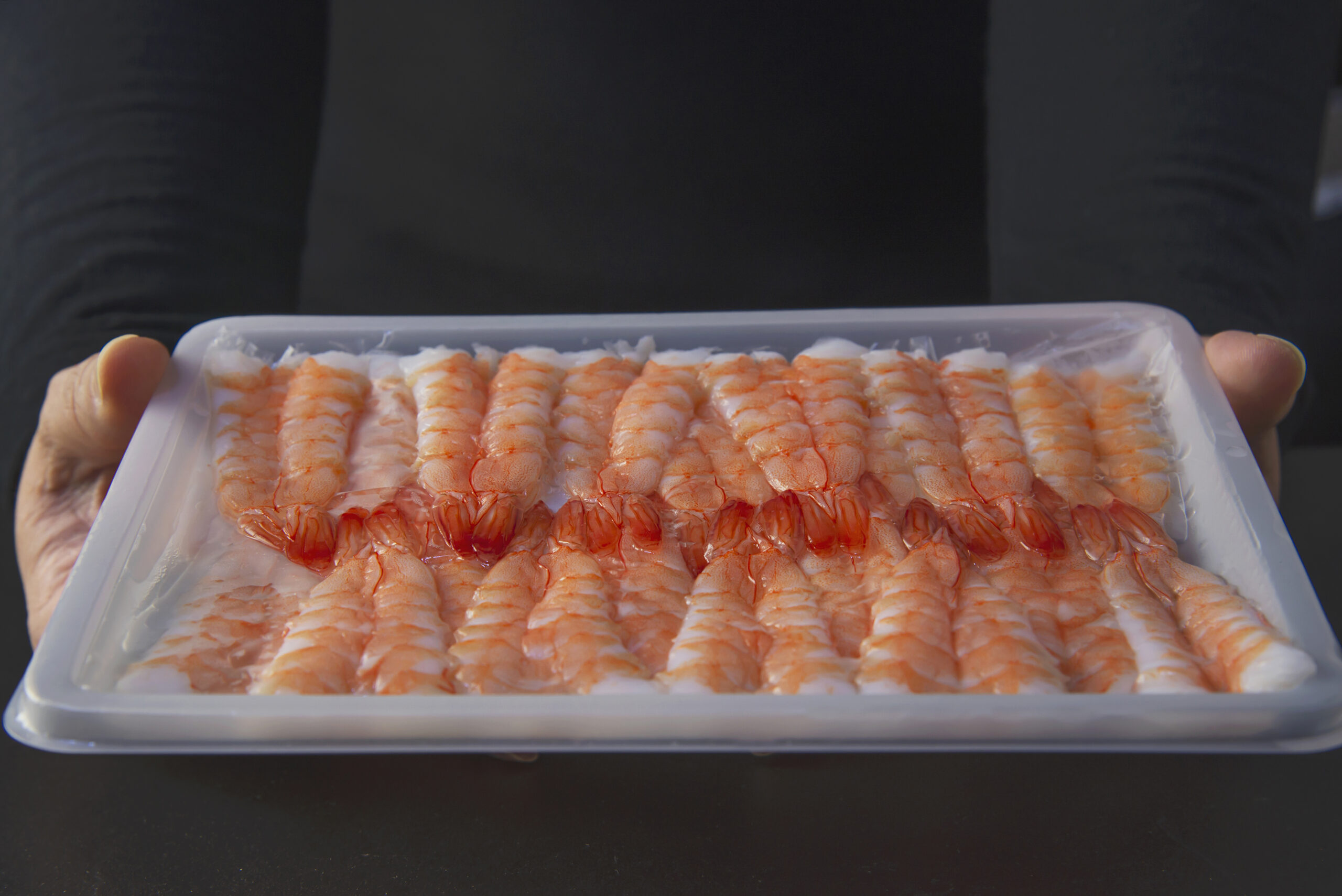Amaebi, or sweet shrimp, is a cherished ingredient in Japanese cuisine known for its delicate texture and sweet flavor. This unique shrimp has captivated the hearts and palates of food enthusiasts worldwide, especially within the realm of sushi. Beyond its culinary applications, amaebi carries cultural significance in Japan and raises questions about sustainability and harvesting practices. This article delves into the distinct characteristics of amaebi, its journey from ocean to plate, and its place in both traditional and modern culinary contexts.
Amaebi: The Delicate Sweet Shrimp of Japanese Cuisine
Amaebi, which translates to "sweet shrimp" in Japanese, is a seasonal delicacy primarily found in the northern Pacific Ocean, off the coasts of Hokkaido and northern Honshu. This shrimp is characterized by its translucent, pinkish hue and notably sweet flavor, which results from its high sugar content. Amaebi is typically served raw and is a staple in sushi bars and traditional kaiseki meals across Japan. The shrimp is appreciated for its delicate flavor, making it a favorite among sushi connoisseurs.
In Japanese cuisine, amaebi is often enjoyed as sashimi, where it is served with a dollop of wasabi and soy sauce to enhance its natural sweetness. The texture of amaebi is exceptionally tender, providing a melt-in-your-mouth experience that is rare among seafood. Chefs take great care in selecting and preparing amaebi to ensure that the inherent qualities of the shrimp are highlighted. This attention to detail is part of what makes amaebi a prized ingredient in many dishes.
Aside from being served as sashimi, amaebi can also be lightly cooked, often seen in tempura preparations or as an ingredient in soups and stews. When cooked, amaebi retains its sweetness while developing a slight crunch, showcasing its versatility. The shrimp is also used in sushi rolls and as a topping for rice bowls, where its unique flavor can shine through without overwhelming other ingredients.
Despite its growing popularity, amaebi remains a seasonal product, typically available during the colder months when the shrimp are at their peak flavor and freshness. This seasonality adds an element of excitement for chefs and diners alike, as they anticipate the arrival of this delicacy each year. As a result, amaebi is not just a food item but an experience that connects people with the rhythms of nature and the changing seasons.
The appreciation for amaebi in Japan goes beyond mere culinary enjoyment; it is a reflection of the country’s deep respect for seasonal ingredients and traditional practices. This delicate shrimp embodies the philosophy of "umami" in Japanese gastronomy, where the balance of flavors and textures is paramount. Amaebi is a testament to the artistry involved in Japanese cooking, where the quality of ingredients is celebrated and meticulously preserved.
As global interest in Japanese cuisine continues to grow, amaebi has found its way onto menus around the world. Its delicate flavor and unique texture have inspired chefs to incorporate this shrimp into various culinary styles, expanding its reach far beyond its traditional roots. The charm of amaebi lies not only in its taste but also in the cultural narratives it carries, making it a captivating subject for both chefs and food lovers.
Understanding the Unique Flavor Profile of Amaebi
Amaebi’s flavor profile is distinct, characterized by its mild sweetness and subtle oceanic notes. Unlike other shrimp varieties, which may have a briny or fishy taste, amaebi offers a clean and sweet experience on the palate. This unique flavor is attributed to the shrimp’s diet, which consists mainly of phytoplankton and other microscopic marine organisms that contribute to its sweetness.
The texture of amaebi is another defining factor in its flavor profile. When consumed raw, the shrimp boasts a silky, almost buttery mouthfeel, which enhances the overall sensory experience. This delicate texture is a result of the shrimp’s low connective tissue content, allowing it to melt effortlessly in the mouth. Chefs often highlight this quality by serving amaebi sashimi-style, with minimal accompaniments, to allow diners to fully appreciate its inherent flavors.
The sweetness of amaebi is often complemented by traditional Japanese condiments such as soy sauce and wasabi. The umami-rich soy sauce enhances the shrimp’s natural flavors, while the sharpness of wasabi adds a layer of complexity. This balance of flavors is essential in Japanese cuisine, where harmony and contrast are key principles. The interplay between sweetness and umami creates a delightful tasting experience that keeps diners coming back for more.
In addition to its natural sweetness, amaebi’s flavor can be enhanced through cooking methods. Lightly grilling or sautéing the shrimp can bring out its caramelized notes, creating a different yet equally enjoyable experience. Chefs may also experiment with seasonings and marinades that complement amaebi’s flavor without overpowering it, showcasing the versatility of this ingredient in various dishes.
The flavor of amaebi is also influenced by its environment and the conditions in which it is harvested. Shrimp caught in colder waters tend to have a sweeter and more pronounced flavor compared to those from warmer regions. This geographical distinction is essential for chefs and suppliers who seek to provide the freshest and most flavorful amaebi to their customers.
Understanding the flavor profile of amaebi is crucial for chefs and home cooks alike. By appreciating its unique characteristics, culinary enthusiasts can explore various preparations and pairings that elevate this delicate shrimp. Whether served raw as sashimi or integrated into a more complex dish, amaebi’s flavor remains a standout feature that continues to captivate food lovers around the world.
The Cultural Significance of Amaebi in Japan
Amaebi is not merely a seafood delicacy; it is a representation of Japanese culture and its deep-rooted appreciation for seasonal ingredients. The Japanese have a long-standing tradition of valuing fresh, high-quality produce, and amaebi exemplifies this ethos perfectly. Its availability during specific seasons is celebrated in culinary practices, making it a symbol of the changing tides and seasons of Japan.
In many regions of Japan, the arrival of amaebi each year is met with excitement and anticipation. Local festivals may include menus that highlight amaebi’s seasonal presence, showcasing it in various preparations that honor its unique flavor. This connection between food and culture is vital in Japan, where each dish tells a story and holds cultural significance.
Amaebi is also associated with the principles of "shun," which signifies the peak seasonality of ingredients. The concept of shun emphasizes the importance of consuming ingredients when they are at their freshest and most flavorful. For many Japanese chefs, sourcing amaebi in its peak season is a rite of passage, reflecting both their culinary skills and their respect for tradition.
In traditional kaiseki meals, where multiple courses are served sequentially, amaebi often plays a starring role in highlighting the season’s best offerings. Its delicate nature and sweet flavor align perfectly with the aesthetic and flavor principles of kaiseki, which seeks to create a harmonious balance between taste, texture, and visual presentation.
Beyond its culinary uses, amaebi also serves as a source of inspiration for artists and artisans in Japan. The shrimp is often depicted in artwork and crafts, symbolizing abundance and the beauty of nature. This cultural representation contributes to its allure and reinforces the importance of amaebi in the broader tapestry of Japanese heritage.
The significance of amaebi extends beyond the plate; it is a reminder of the interconnectedness between nature, culture, and cuisine. As global interest in Japanese food continues to rise, understanding the cultural context of ingredients like amaebi is essential for appreciating the depth and richness of Japanese culinary traditions.
How Amaebi is Harvested: A Deep Dive Into Sustainability
The sustainable harvesting of amaebi is a critical concern for both consumers and industry practitioners. As demand for this delicate shrimp increases globally, ensuring that harvesting practices are environmentally responsible has become paramount. Amaebi fishing typically occurs in the colder waters off the northern coasts of Japan, where the shrimp are abundant during specific seasons.
Harvesting amaebi primarily involves bottom trawling, a method that has raised concerns regarding its impact on marine ecosystems. This fishing technique can disrupt sea floor habitats and unintentionally catch non-target species. As awareness of these issues has grown, fisheries and regulators have begun implementing measures to promote sustainable fishing practices.
Many Japanese fisheries have adopted eco-friendly practices, such as using selective fishing gear that minimizes bycatch and protects juvenile shrimp populations. These initiatives are essential for preserving the amaebi population and ensuring that the shrimp can continue to thrive in its natural habitat. Furthermore, the Japanese government and various organizations are actively working to monitor and regulate amaebi fishing to prevent overfishing.
In recent years, there has been a shift towards aquaculture as a sustainable alternative to wild harvesting. Some producers have begun cultivating amaebi in controlled environments, allowing for a steady supply without depleting natural populations. While this practice is still relatively new, it presents an opportunity to maintain the delicate balance of marine ecosystems while meeting consumer demand.
Sustainability in amaebi harvesting also encompasses community involvement and education. Many fishing communities in Japan are invested in promoting responsible fishing practices and preserving their local marine environments. By engaging with local fishermen and educating consumers about the importance of sustainability, the industry can work towards a more responsible future for amaebi.
As consumers become more conscious of sourcing sustainably, the demand for transparency in the supply chain has increased. Chefs and restaurants are now more frequently sourcing amaebi from fisheries that adhere to sustainable practices, thus supporting the preservation of this delicate shrimp for future generations. This consciousness around sustainability not only benefits the environment but also enriches the dining experience by connecting consumers to the source of their food.
Amaebi’s Journey: From Ocean to Sushi Plate
The journey of amaebi from ocean to sushi plate involves several key stages, each crucial for maintaining the shrimp’s quality and freshness. Once harvested, amaebi is typically kept in temperature-controlled environments to preserve its delicate texture and sweet flavor. This careful handling begins immediately after the shrimp are caught to prevent deterioration.
Upon arrival at processing facilities, amaebi is sorted and graded based on size, freshness, and appearance. This meticulous process ensures that only the highest-quality shrimp make it to the market. Grading amaebi involves assessing its color, clarity, and overall condition; these factors contribute to the shrimp’s culinary appeal and market value.
Once graded, amaebi is cleaned and prepared for distribution. Some suppliers choose to sell the shrimp raw, while others may lightly cook it to enhance its flavor and texture. In either case, maintaining the shrimp’s freshness is paramount, and many suppliers utilize advanced refrigeration techniques to ensure that amaebi reaches its destination in pristine condition.
The distribution of amaebi to sushi bars and restaurants requires careful logistics. Many chefs prefer sourcing amaebi from local suppliers to ensure that the shrimp is as fresh as possible. This emphasis on local sourcing reflects a broader trend in the culinary world, where freshness and quality are prioritized over convenience.
Once in the hands of chefs, amaebi is often served raw as sashimi, highlighting its delicate flavor and texture. Skilled sushi chefs take pride in their ability to prepare amaebi in a way that showcases its natural sweetness while elevating the overall dining experience. This may involve pairing the shrimp with seasonal ingredients or presenting it in an aesthetically pleasing manner.
For home cooks, obtaining amaebi may involve visiting specialty seafood markets or ordering from reputable suppliers. As awareness of this delicacy grows, more markets are beginning to stock amaebi, making it more accessible to food enthusiasts eager to explore its unique flavors. The journey of amaebi—from ocean to plate—underscores the importance of quality and freshness in Japanese cuisine, ensuring that this delicate shrimp remains a prized ingredient.
The Art of Preparing Amaebi: Techniques and Tips
Preparing amaebi requires a level of skill and understanding to truly highlight its delicate nature and unique flavor. The first step in preparing amaebi is selecting high-quality shrimp, which should be translucent with a slight pink hue. Freshness is key; when purchasing amaebi, look for signs of vitality such as a firm texture and a mild ocean scent.
When it comes to slicing amaebi for sashimi, precision is crucial. Use a sharp, thin-bladed knife to ensure clean cuts that will not bruise the shrimp. Many chefs recommend cutting the amaebi in half lengthwise, which allows diners to appreciate the shrimp’s tender texture fully. Alternatively, amaebi can be served whole, with chefs carefully removing the head and shell to leave the sweet flesh intact.
For a more elevated presentation, amaebi can be lightly marinated or topped with sauces that complement its natural sweetness. A simple mix of soy sauce and a hint of yuzu juice can enhance the shrimp’s flavor without overshadowing it. Experimenting with various condiments, such as ponzu sauce or a drizzle of sesame oil, allows chefs to add their personal touch while respecting amaebi’s delicate character.
When cooking amaebi, less is often more. Lightly grilling or sautéing the shrimp can enhance its sweetness and provide a pleasant texture without compromising its innate qualities. Avoid overcooking, as this can quickly lead to a loss of flavor and texture. The aim should be to achieve a just-cooked state that retains amaebi’s tender bite.
As amaebi is best enjoyed fresh, it is advisable to prepare it just before serving. While some dishes incorporate amaebi into cooked preparations, such as soups or tempura, the most revered presentations focus on raw consumption. This practice highlights the shrimp’s sweet flavor and velvety texture, allowing diners to experience amaebi in its purest form.
Finally, serving amaebi with seasonal accompaniments enhances the overall dining experience. Pairing amaebi with fresh wasabi, pickled vegetables, or a side of warm rice can create a well-rounded dish that celebrates the intricacies of Japanese cuisine. The art of preparing amaebi lies not only in the techniques used but also in the respect for the ingredient that has made it a beloved staple of Japanese culinary tradition.
Amaebi vs. Other Shrimp Varieties: What Sets It Apart?
Amaebi stands out among various shrimp varieties due to its unique flavor, texture, and usage in culinary traditions. While many types of shrimp are commonly used in cuisines worldwide, amaebi’s delicate sweetness and tender mouthfeel set it apart. In contrast to more robust shrimp varieties, such as tiger shrimp or white shrimp, amaebi is appreciated for its subtlety and refined taste.
One of the primary distinctions between amaebi and other shrimp varieties is its sweetness. Amaebi is known for a high sugar content that results in a naturally sweet flavor, which is less pronounced in other shrimp types. This quality makes amaebi particularly appealing to those looking for a milder, more nuanced seafood experience.
From a textural perspective, amaebi offers a softness that is rarely found in other shrimp. Its low connective tissue content results in a melt-in-your-mouth sensation, making it ideal for sashimi preparations. Other shrimp varieties, such as cooked bay shrimp or larger varieties like king shrimp, often have a firmer texture that holds up well to grilling or frying but may not provide the same delicate experience as amaebi.
In terms of culinary applications, amaebi is typically reserved for high-end dining settings, where its quality can be showcased without overwhelming other flavors. Chefs often use amaebi as a centerpiece in sushi presentations or as a highlight in multi-course meals. In contrast, other shrimp varieties may find more frequent use in stir-fries, soups, or casual dishes where a bolder flavor profile is desired.
Another key difference lies in the seasonal availability of amaebi. This shrimp is primarily harvested during the colder months, making it a seasonal delicacy. In comparison, many other shrimp varieties are available year-round, allowing for more versatility in cooking. The seasonal nature of amaebi adds to its allure, creating anticipation among chefs and diners alike.
Ultimately, the appeal of amaebi stems from its unique qualities that cater to a specific culinary niche. While other shrimp varieties offer their own advantages and flavors, amaebi stands out for its delicate sweetness and texture, making it a sought-after ingredient in Japanese cuisine. Its rarity and seasonal charm continue to capture the imaginations of chefs and food lovers worldwide.
The Health Benefits of Eating Amaebi: A Nutritional Overview
Amaebi is not only a culinary delight but also a healthy food choice that offers various nutritional benefits. This delicate shrimp is an excellent source of protein, providing essential amino acids necessary for muscle repair and overall body function. A typical serving of amaebi is low in calories, making it an attractive option for health-conscious consumers looking for nutritious seafood.
In addition to protein, amaebi contains beneficial omega-3 fatty acids, which are known for their heart health benefits. Omega-3s play a crucial role in reducing inflammation, lowering blood pressure, and improving overall cardiovascular health. Including amaebi in a balanced diet can help individuals meet their daily recommended intake of these essential fats.
Amaebi is also rich in vitamins and minerals, including vitamin B12, selenium, and zinc. Vitamin B12 is essential for maintaining healthy nerve function and red blood cell production, while selenium is a powerful antioxidant that supports the immune system. Zinc is crucial for various bodily functions, including wound healing and maintaining a healthy sense of taste and smell.
Another benefit of amaebi is its low mercury content compared to larger predatory fish and shrimp varieties. This makes amaebi a safer seafood option for those concerned about mercury exposure, particularly pregnant women and children. The relatively low levels of contaminants in amaebi contribute to its appeal as a healthy seafood choice.
Furthermore, amaebi is often enjoyed raw, as in sashimi, which preserves its nutritional value. Cooking can sometimes diminish the nutritional content of certain foods, but consuming amaebi fresh allows individuals to reap the full benefits of its vitamins and minerals.
Incorporating amaebi into a balanced diet can contribute to overall health while also indulging in the unique flavors of Japanese cuisine. As interest in healthy eating continues to grow, amaebi presents an enticing option for those looking to enjoy delicious seafood without compromising their nutritional needs.
Pairing Amaebi: Best Accompaniments and Pairings
When it comes to pairing amaebi, the goal is to enhance its delicate sweetness while maintaining balance with complementary flavors. Traditional accompaniments such as soy sauce and wasabi are classic choices that highlight amaebi’s natural qualities without overshadowing them. The umami richness of soy sauce enhances the shrimp’s sweetness, while wasabi adds a subtle kick that elevates the overall experience.
In addition to soy sauce and wasabi, yuzu, a citrus fruit native to East Asia, can be an excellent companion for amaebi. The bright acidity of yuzu juice or zest can accentuate the shrimp’s natural flavors, providing a refreshing contrast. A light yuzu dressing drizzled over amaebi can create a harmonious balance that enhances its sweetness while adding a zesty note.
For those looking to explore more adventurous pairings, consider incorporating seasonal accompaniments. Fresh herbs, such as shiso or microgreens, can add an aromatic touch to amaebi dishes. The peppery flavor of shiso complements the shrimp’s delicacy, making it an ideal garnish for sashimi presentations or sushi rolls.
Another delightful pairing is with pickled vegetables, which provide a contrasting tanginess that cuts through amaebi’s sweetness. Quick-pickled radishes or cucumber can add texture and brightness to a dish, enhancing the overall flavor profile while providing a visual appeal. This combination is often seen in traditional Japanese meals, where the balance of flavors is paramount.
When serving amaebi in cooked preparations, such as tempura or grilled dishes, consider pairing it with dipping sauces that highlight its flavor. A ponzu sauce, made from soy sauce, citrus, and vinegar, can add a zesty dimension that complements amaebi’s sweetness while providing a bit of acidity. Alternatively, a light sesame sauce can enhance the shrimp’s flavor without overwhelming it.
Wine and beverage pairings are also essential considerations when serving amaebi. A crisp, dry sake can enhance the umami notes of the shrimp, while a light white wine, such as a Sauvignon Blanc or Pinot Grigio, can provide refreshing acidity that complements amaebi’s sweetness. For non-alcoholic options, a citrus-infused sparkling








